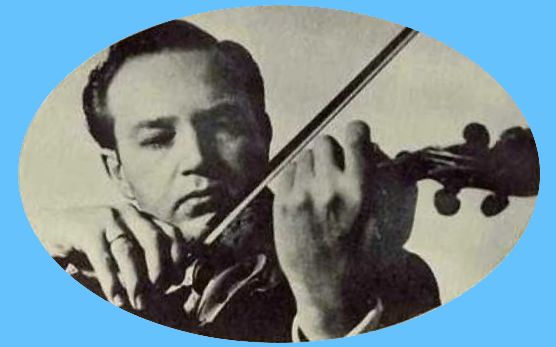Le portrait de Franz MARSZALEK à droite en haut vient de cette page du site www.radiomusaeum.org, «Der schon mehrere Jahre in der Schlesischen Funkstunde tätige Franz Marszalek wurde nunmehr zum Leiter der Schlesischen Funkkapelle ernannt». Pour la photo en-dessous, je n'en connais pas l'origine exacte: si une personne visitant cette page devait en savoir plus, toutes informations m'intéressent -> Vos remarques!
À gauche Henri Wieniawski en 1878, Brustbild, Fotograf: Straub & Kühn, Universitätsbibliothek der Johann Wolfgang Goethe-Universität Frankfurt am Main, Porträtsammlung Manskopf, Signatur des Originals: S 36/F02160, «Die Weiterverbreitung von Inhalten, auch in Auszügen, für pädagogische, wissenschaftliche oder private Zwecke ist unter Angabe der Quelle gestattet»; en-dessous Page de couverture de la partition de l'opus 21 d'Henryk Wieniawski, Mainz, Schott, Pl. Nr 21754, 1875.
Henryk WIENIAWSKI
2e Polonaise brillante pour le violon avec accompagnement d'orchestre ou de piano en la majeur, op. 21
Ricardo ODNOPOSOFF
Orchestre Symphonique de la Radio de Cologne
Franz MARSZALEK
1958, Salle Klaus-von-Bismarck de la
Maison de la Radio de Cologne
À l’âge de 18 ans, Henryk Wieniawski avait composé sa Polonaise brillante no 1, op. 4. La Polonaise brillante no 2, op. 21, fut écrite environ 17 ans plus tard et donnée en première audition dans sa version orchestrale le 17 mars 1870, par le compositeur dans le Grand Theatre de Saint Petersburg (ref.: cette page du site www.wieniawski.com). C'est probablement peu après, lors d'une tournée en Suède, qu'il présenta - et dédicaça - un manuscript de cette polonaise à Charles XV, roi de Norvège et Suède. À l'impression de la première édition il dédicaça toutefois l'oeuvre «à son ami Francois van Hal (de Bruxelles)» (voir la photo de la page de couverture de la partition, à gauche).
"[...] The Polonaise in A-major was written at approximately the same time as the 2-nd Concert in D-major. This convergence in time had influenced a certain similarity with regard to both composition and technical means, and also to the themes. In particular, the similarity strikes as quite obvious in the second theme of the Allegro in the Concert, and in the theme of the Polonaise. The Polonaise in A-major is also in a certain way convergent with the first Polonaise (in D-major), namely the themes of the motifs in both Polonaises are alike. In real terms, though, both pieces stand vary much apart with respect to style. The Polonaise in D-major constitutes a proof of the composer’s fascination with the range of technical means available to him. Wieniawski makes the most of the doubles, chords, and all other sophisticated virttuoso techniques. The Polonaise in A-major, written 18 years later, is much more mature. Although it is a virtuoso piece as well, it is nonetheless somewhat more limiting as to the variety of the range of techniques, and the choices had been made in accordance with the needs of expression. The virtuoso character of this piece is more fragile, much closer to the brillant style. At the same time, the Polonaise is typical for Wieniawski’s violin playing technique. Here, the composer uses the means regarded by his contemporaries to be typical, e.g. long staccato fragments played with one bow.
The published Polonaise is a well developed concert piece in one part, has a reprisive character, while the reprise is, to a large extent, abbreviated. The middle fragment is contrasting in character, thanks to the change in key (F-major), the reduction in the number of instruments (in the orchestral version), and slowing down the pace. All the fragments show thematic similarity. The first fragment, too, has a similar section structure, including a contrasting middle section (in E-major).
The Polonaise in A-major is a typical virtuoso style piece, where the solo violin decisively plays a dominant role. [...]
The orchestra is clearly there only to accompany the soloist, it is subordinated to the soloist, just like in the brillant type concerts. However the Polonaise in A-major was written in the times when the set of instruments in the orchestra and the way in which they collaborated varied from the classic standard, Wieniawski in principle, uses a classic orchestra set. Except for the three trombones, all other wind instruments are doubled and, as far as the percussion family of instruments is concerned, only kettledrums participate. The latter, and the brass wind instruments, join in only in the tutti fragments, and their function is dynamic. As a matter of fact, a string quintet constitutes the basis for the orchestra, and is supplemented by wooden wind instruments, often played as if in a soloist manner.[...]" cité d'un texte de Zofia Chechlinska publié sur cette page du site www.wieniawski.com.

Ricardo ODNOPOSOFF est ici accompagné par l'Orchestre Symphonique de la Radio de Cologne (Kölner Rundfunk-Sinfonie-Orchester, l'actuel WDR Sinfonieorchester Köln), dirigé par Franz MARSZALEK. Cet enregistrement a été fait en 1958 dans la salle «Klaus-von-Bismarck» de la Maison de la Radio de la «Westdeutsche Rundfunk» (WDR). Je n'ai pas encore pu déterminer avec certitude s'il s'agit d'un enregistrement de studio ou de concert: si une personne visitant cette page devait en savoir plus, toutes informations m'intéressent -> Vos remarques!
Voici donc...
Henryk Wieniawski, 2e Polonaise brillante pour le violon avec accompagnement d'orchestre ou de piano en la majeur, op. 21, Ricardo ODNOPOSOFF, Orchestre Symphonique de la Radio de Cologne, Franz MARSZALEK, 1958, Klaus-von-Bismarck-Saal, Kölner Funkhaus am Wallraff-Platz (Allegro moderato - Piu moderato ed grandosio 08:51)
que vous pouvez obtenir en...
pour un téléchargement libre, depuis mon site
Radiodiffusion (Archives WDR) -> WAV -> FLAC
1 fichier FLAC, 2 fichiers CUE (*) et 1 fichier PDF dans 1 fichier ZIP
(*) 1 fichier CUE pour les fichiers décomprimés en WAV et 1 fichier CUE pour les fichiers comprimés FLAC, si votre logiciel peut utiliser directement les fichiers FLAC.
Page de couverture de la partition de l'opus 21 d'Henryk Wieniawski, Mainz, Schott, Pl. Nr 21754, 1875, www.wieniawski.com

